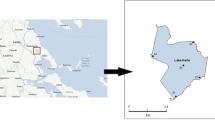Abstract
This paper describes a two-dimensional lake breeze model with turbulent energy closure. The simulated results show that (1) the front of the lake breeze progresses inland faster in the late afternoon than at the fully developed stage; and (2) the lake breeze and land breeze have larger, extension offshore than inland. The acceleration of the front in the declining phase of the lake breeze is explained in terms of the decreased turbulent friction acting on the head of the lake breeze. The larger, extension offshore, probably, is attributed to the smaller roughness of water surface and to the offshore synoptic wind.
Similar content being viewed by others
References
Atkinson, B. W. (1981),Meso-scale Atmospheric Circulations (chapter 5). Academic Press, London.
Bergström, H. and Alexandersson, H. (1981), Atmospheric Boundary Layer Field Experiment in Sweden 1980, part II. Report No. 65, Uppsala.
Bodin, S., (1979), A predictive Numerical Model of the Atmospheric Boundary Layer Based on the Turbulent Energy Equation,SMHI Report, RMK 13.
Bodin, S., Ericson, K. and Schoeffler, P. (1980), Where and how will a radioactive cloud from Barsebäck land?SMHI Reprot, FoU-notiser Nr 9.
Dalu, G. A., and Green, J. S. A. (1980), Energetics of diabatic mesoscale circulation; A numerical study.Quart. J.R. Met. Soc.,106, 727–734.
Ericson, K. (1982), Atmospheric Boundary Layer Field Experiment in Sweden 1980. Part 1,SMHI Reports, RMK 33.
Estoque, M. A., Gross, J. and Lai, H. W. (1976), A Lake Breeze over, Southern Lake Ontario.
Hoke, J. E. and Anthes, R. A. (1976), The initialization of numerical models by a dynamic-initialization technque,Mon. Weather Rev.,104: 1551–1556.
Longhetto, A. (Editor) (1980),Atmospheric Planetary Boundary Layer Physics (Chapter 1–3), Elsevier scientific publishing company.
Melgareio, J. (1980), Numerical experiments of wind over Gotland with a two-dimensional mesometeorological boundary layer model,SMHI Report, FoU-notiser Nr 11.
Neumann, J. and Mahrer, Y. (1974), A theoretical study of the sea and land breeze of circular island.J. Atmos. Sci.,31: 2027–2039.
Physick, W. L. (1980), Numerical experiments on the inland penetration of the sea breeze,Quart. J.R. Met. Soc.,106: 735–746.
Pielke, R. A. (1984),Mesoscale Meteorological Modeling (Chapter 7, 11). Academic Press, INC.
Saito, N. (1976), Numerical experiments of the land and sea breeze circulation,Papers in Meteorology and Geophysics, Vol. 27, No. 4, 99–117.
Simpson, J. E., Mansfield, D. A. and Milford, J. R. (1977), Inland penetration of sea breeze fronts,Quart. J.R. Met. Soc.,103: 47–76.
Therry, G. and Lacarrére, P. (1983), Improving the eddy kinetic energy model for planetary boundary layer description,Bound. Layer Met.,25: 63–68.
Author information
Authors and Affiliations
Rights and permissions
About this article
Cite this article
Zengmao, W. Numerical study of lake-land breeze over lake vättern Sweden. Adv. Atmos. Sci. 4, 198–209 (1987). https://doi.org/10.1007/BF02677066
Received:
Issue Date:
DOI: https://doi.org/10.1007/BF02677066



